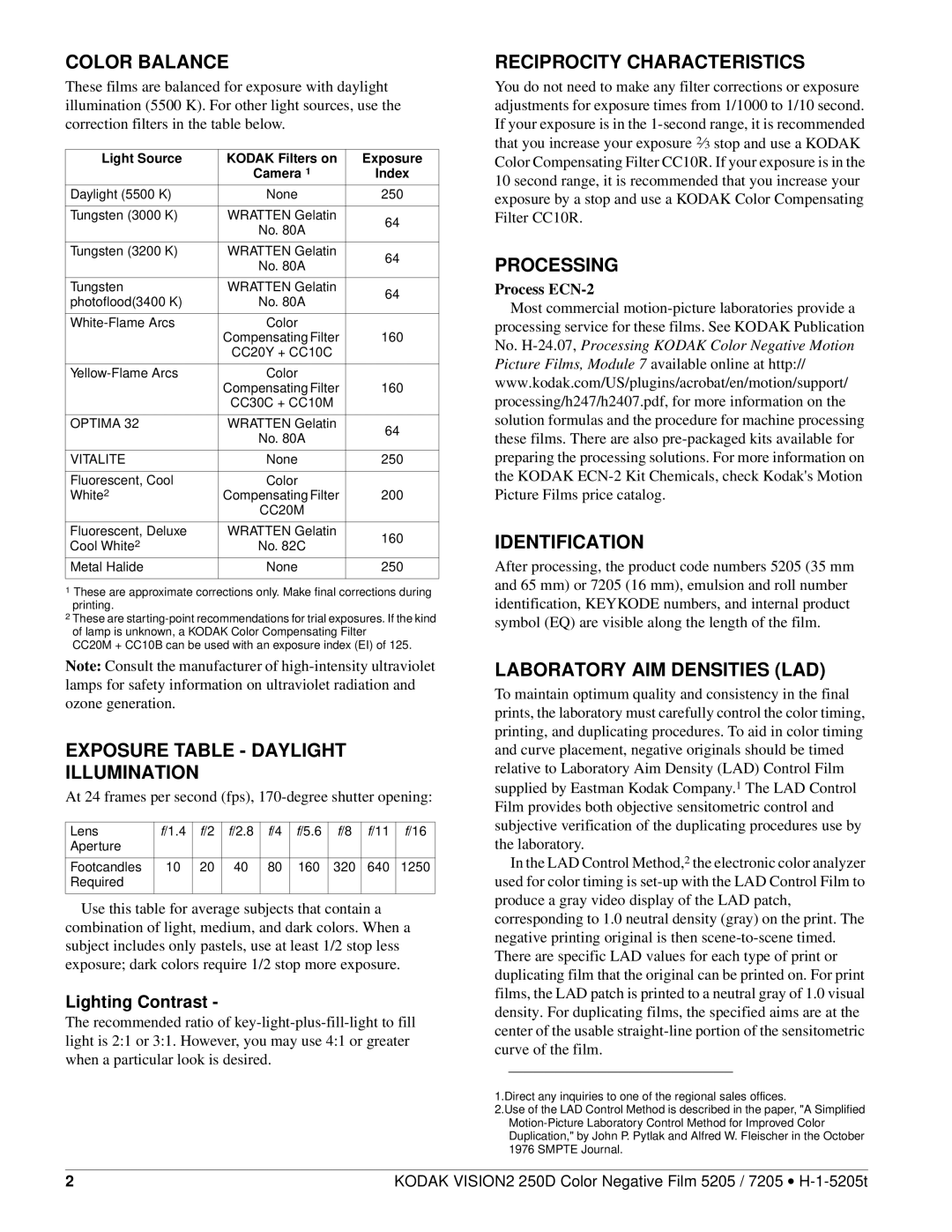COLOR BALANCE
These films are balanced for exposure with daylight illumination (5500 K). For other light sources, use the correction filters in the table below.
Light Source | KODAK Filters on | Exposure | |
| Camera 1 | Index | |
Daylight (5500 K) | None | 250 | |
|
|
| |
Tungsten (3000 K) | WRATTEN Gelatin | 64 | |
| No. 80A | ||
|
| ||
|
|
| |
Tungsten (3200 K) | WRATTEN Gelatin | 64 | |
| No. 80A | ||
|
| ||
|
|
| |
Tungsten | WRATTEN Gelatin | 64 | |
photoflood(3400 K) | No. 80A | ||
| |||
|
|
| |
Color |
| ||
| Compensating Filter | 160 | |
| CC20Y + CC10C |
| |
|
|
| |
Color |
| ||
| Compensating Filter | 160 | |
| CC30C + CC10M |
| |
|
|
| |
OPTIMA 32 | WRATTEN Gelatin | 64 | |
| No. 80A | ||
|
| ||
|
|
| |
VITALITE | None | 250 | |
|
|
| |
Fluorescent, Cool | Color |
| |
White2 | Compensating Filter | 200 | |
| CC20M |
| |
|
|
| |
Fluorescent, Deluxe | WRATTEN Gelatin | 160 | |
Cool White2 | No. 82C | ||
| |||
Metal Halide | None | 250 | |
|
|
|
1These are approximate corrections only. Make final corrections during printing.
2These are
CC20M + CC10B can be used with an exposure index (EI) of 125.
Note: Consult the manufacturer of
EXPOSURE TABLE - DAYLIGHT ILLUMINATION
At 24 frames per second (fps),
Lens | f/1.4 | f/2 | f/2.8 | f/4 | f/5.6 | f/8 | f/11 | f/16 |
Aperture |
|
|
|
|
|
|
|
|
|
|
|
|
|
|
|
|
|
Footcandles | 10 | 20 | 40 | 80 | 160 | 320 | 640 | 1250 |
Required |
|
|
|
|
|
|
|
|
|
|
|
|
|
|
|
|
|
Use this table for average subjects that contain a combination of light, medium, and dark colors. When a subject includes only pastels, use at least 1/2 stop less exposure; dark colors require 1/2 stop more exposure.
Lighting Contrast -
The recommended ratio of
RECIPROCITY CHARACTERISTICS
You do not need to make any filter corrections or exposure adjustments for exposure times from 1/1000 to 1/10 second. If your exposure is in the
PROCESSING
Process
Most commercial
IDENTIFICATION
After processing, the product code numbers 5205 (35 mm and 65 mm) or 7205 (16 mm), emulsion and roll number identification, KEYKODE numbers, and internal product symbol (EQ) are visible along the length of the film.
LABORATORY AIM DENSITIES (LAD)
To maintain optimum quality and consistency in the final prints, the laboratory must carefully control the color timing, printing, and duplicating procedures. To aid in color timing and curve placement, negative originals should be timed relative to Laboratory Aim Density (LAD) Control Film supplied by Eastman Kodak Company.1 The LAD Control Film provides both objective sensitometric control and subjective verification of the duplicating procedures use by the laboratory.
In the LAD Control Method,2 the electronic color analyzer used for color timing is
1.Direct any inquiries to one of the regional sales offices.
2.Use of the LAD Control Method is described in the paper, "A Simplified
2 | KODAK VISION2 250D Color Negative Film 5205 / 7205 • |
